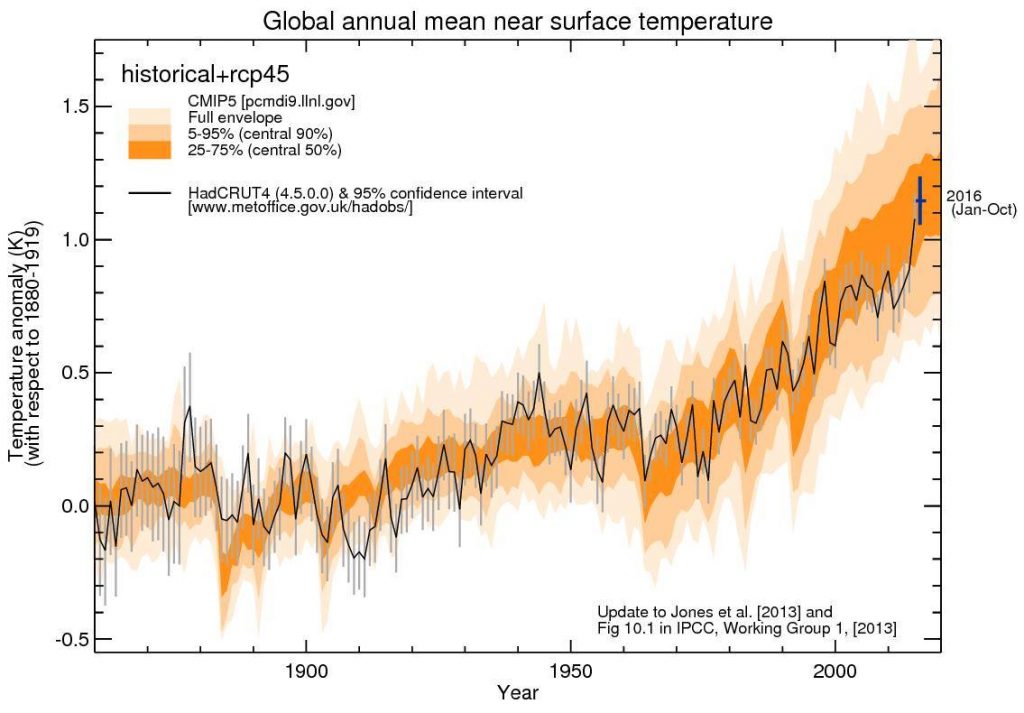6 December 2016
Another Smoking Gun that the Earth’s Thermostat is Going Haywire
Posted by Dan Satterfield

Dr,. Katharine Hayhoe’s tweet was worth sharing here. The fake news machines have been fairly wild lately, but she tweeted some more hard facts.
While those who do not live in the world of facts share fake news stories about the planet’s temperature dropping, the real data is far different. We will almost certainly set a new hottest year on record this year, breaking the previous record, last year, and the current second place holder, the year before that!
Meteorologist Guy Walton keeps close track of the number of record highs versus record lows in the U.S., and he sent me some more amazing data over the weekend. First some background: In a stable climate, you would expect the number of new record highs would equal the number of record lows, at least in the long-term. Some years would see an excess of one or the other, but all in all, it would be a 50/50 split in the long run. It’s kind of like flipping a quarter for heads or tails. It’s not a big deal to get a run of 4 or 5 heads, but everyone knows that if you flip it 400 times, the number will be pretty close to average.
Unless the coin has been tampered with.
In this case, it’s the climate that is being tampered with, and the heads and tails definitely do not match. Not only that, but the coin is getting more and more wacky.
For the U.S. in November, The count now stands at 4,537 record highs to 94 record lows. That is a ratio of 48 to 1!
Here are the numbers for the years from 2010 through 2015:

For 2016 so far (one month to go) we have had 27,398 record highs to 4,099 record lows. I’ll save you the maths- the ratio is 5.7 record highs for every record low. For 2000-2010 we have seen about 2 record highs for each record low.
You might wonder how this ratio will change as the planet warms, and you wouldn’t be alone. Comparing record highs to record lows is not an “apples to apples” comparison. The statistics can be messy*, but a new paper in the Proceeding of the National Academies of Science took a look at just that question, and it delves into the difficulties involved. One of the authors is Gerald Meehl (at the National Center for Atmospheric Research) whose been looking at this for over a decade now, and co-authors Claudia Tebaldi at NCAR, and Dennis Adams-Smith at Climate Central in Princeton. The paper was edited by Dr. Kerry Emanuel at MIT ( well-known for his research into hurricanes and how they may change as the planet warms), so what I’m saying is that those names on a paper get my serious attention.

The global climate models continue to get better and better. Look how close the model forecast matches the actual planetary temperature record. These same models indicate well above a 3°C rise in temperature if we continue to increase the rate of fossil fuel burning.
The authors used the latest global climate models that couple the oceans and the atmosphere to project how often record highs would be seen vs record lows. What did they find? If the planet warms 3°C then we will see a ratio of around 15 record highs to each record low, and if we continue to increase the carbon in our atmosphere in a business as usual scenario, we will reach 3°C well before the end of this century.
I do not forecast a snow storm without many independent lines of evidence that support it (Those that just look at raw model guidance on the internet often do, and cause alarm for no reason), and science always works this way. We are not telling you that our stable climate is in peril based on any one piece of evidence. Multiple lines of high confidence evidence all point to almost the same answer.
We must change our way of producing energy, and soon. Not so much because of what we pretty much know will happen (That’s bad enough), but because of the surprises we do not yet know of. That should keep anyone under 30 up at night, and it should downright alarm anyone under 12.
*As my climate scientist friends would probably say – the problem is “non-trivial”.


 Dan Satterfield has worked as an on air meteorologist for 32 years in Oklahoma, Florida and Alabama. Forecasting weather is Dan's job, but all of Earth Science is his passion. This journal is where Dan writes about things he has too little time for on air. Dan blogs about peer-reviewed Earth science for Junior High level audiences and up.
Dan Satterfield has worked as an on air meteorologist for 32 years in Oklahoma, Florida and Alabama. Forecasting weather is Dan's job, but all of Earth Science is his passion. This journal is where Dan writes about things he has too little time for on air. Dan blogs about peer-reviewed Earth science for Junior High level audiences and up.